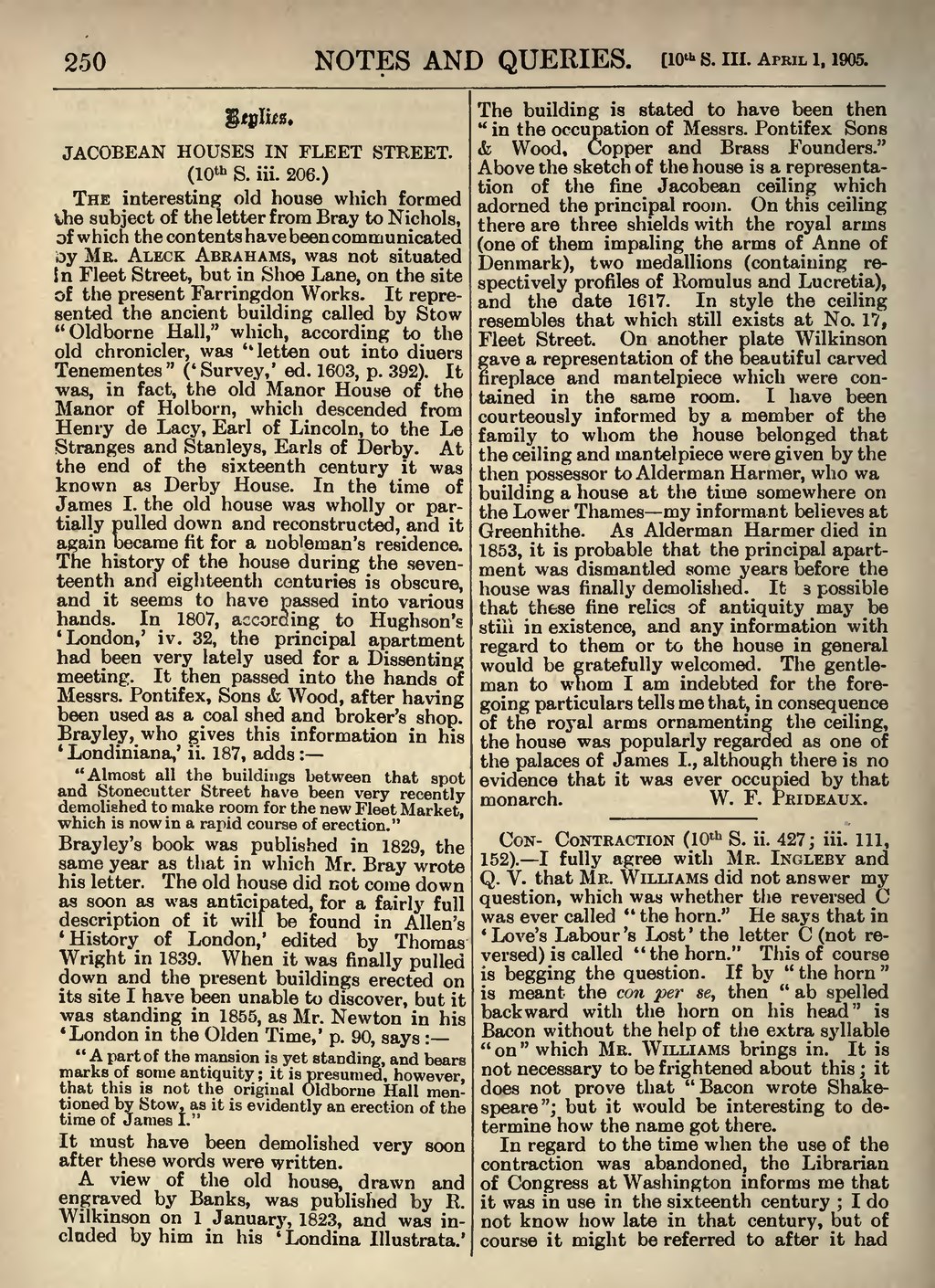250
NOTES AND QUERIES. [io* s. m. APRIL i, 1905.
JACOBEAN HOUSES IN FLEET STREET.
(10 th S. iii. 206.)
THE interesting old house which formed vhe subject of the letter from Bray to Nichols, of which the contents have been communicated oy MR. ALECK ABRAHAMS, was not situated in Fleet Street, but in Shoe Lane, on the site of the present Farringdon Works. It repre- sented the ancient building called by Stow "Oldborne Hall," which, according to the old chronicler, was letten out into diuers Tenementes" ('Survey,' ed. 1603, p. 392). It was, in fact, the old Manor House of the Manor of Holborn, which descended from Henry de Lacy, Earl of Lincoln, to the Le Stranges and Stanleys, Earls of Derby. At the end of the sixteenth century it was known as Derby House. In the time of James I. the old house was wholly or par- tially pulled down and reconstructed, and it again became fit for a nobleman's residence. The history of the house during the seven- teenth and eighteenth centuries is obscure, and it seems to have passed into various hands. In 1807, according to Hughson's 'London,' iv. 32, the principal apartment had been very lately used for a Dissenting meeting. It then passed into the hands of Messrs. Pontifex, Sons & Wood, after having been used as a coal shed and broker's shop. Brayley, who gives this information in his ' Londiniana,' ii. 187, adds :
"Almost all the buildings between that spot and Stonecutter Street have been very recently demolished to make room for the new Fleet Market, which is now in a rapid course of erection." Brayley's book was published in 1829, the same year as that in which Mr. Bray wrote his letter. The old house did not come down as soon as was anticipated, for a fairly full description of it will be found in Allen's 'History of London,' edited by Thomas Wright in 1839. When it was finally pulled down and the present buildings erected on its site I have been unable to discover, but it was standing in 1855, as Mr. Newton in his 'London in the Olden Time,' p. 90, says :
"A part of the mansion is yet standing, and bears marks of some antiquity; it is presumed, however, that this is not the original Oldborne Hall men- tioned by Stow, as it is evidently an erection of the time of James I."
It must have been demolished very soon after these words were written.
A view of the old house, drawn and engraved by Banks, was published by E. Wilkinson on 1 January, 1823, and was in- cluded by him in his 'Londina Illustrata.'
The building is stated to have been then
" in the occupation of Messrs. Pontifex Sons
& Wood, Copper and Brass Founders."
Above the sketch of the house is a representa-
tion of the fine Jacobean ceiling which
adorned the principal room. On this ceiling
there are three shields with the royal arms
(one of them impaling the arms of Anne of
Denmark), two medallions (containing re-
spectively profiles of llomulus and Lucretia),
and the date 1617. In style the ceiling
resembles that which still exists at No. 17,
Fleet Street. On another plate Wilkinson
gave a representation of the beautiful carved replace and mantelpiece which were con- tained in the same room. I have been courteously informed by a member of the family to whom the house belonged that the ceiling and mantelpiece were given by the then possessor to Alderman Harmer, who wa building a house at the time somewhere on the Lower Thames my informant believes at Greenhithe. As Alderman Harmer died in 1853, it is probable that the principal apart- ment was dismantled some years before the house was finally demolished. It s possible that these fine relics of antiquity may be still in existence, and any information with regard to them or to the house in general would be gratefully welcomed. The gentle- man to whom I am indebted for the fore- going particulars tells me that, in consequence of the royal arms ornamenting the ceiling, the house was popularly regarded as one of the palaces of James I., although there is no evidence that it was ever occupied by that monarch. W. F. PRIDEAUX.
CON- CONTRACTION (10 th S. ii. 427; iii. Ill,
152). I fully agree with MR. INGLEBY and
Q. V. that MR. WILLIAMS did not answer my
question, which was whether the reversed C
was ever called " the horn." He says that in
'Love's Labour's Lost' the letter C (not re-
versed) is called "the horn." This of course
is begging the question. If by " the horn "
is meant the con per se, then " ab spelled
backward with the horn on his head" is
Bacon without the help of the extra syllable
"on" which MR. WILLIAMS brings in. It is
not necessary to be frightened about this ; it
does not prove that " Bacon wrote Shake-
speare"; but it would be interesting to de-
termine how the name got there.
In regard to the time when the use of the contraction was abandoned, the Librarian of Congress at Washington informs me that it was in use in the sixteenth century ; I do not know how late in that century, but of course it might be referred to after it had
